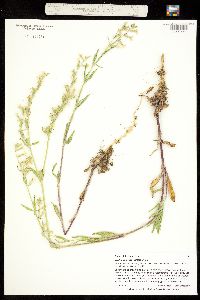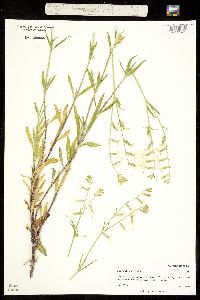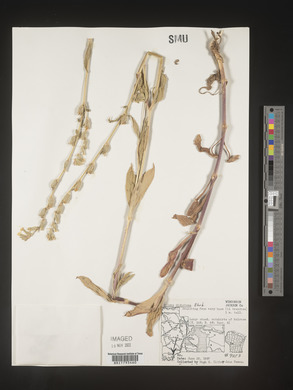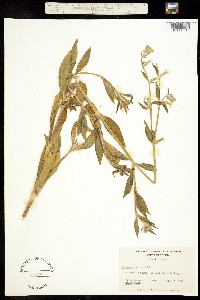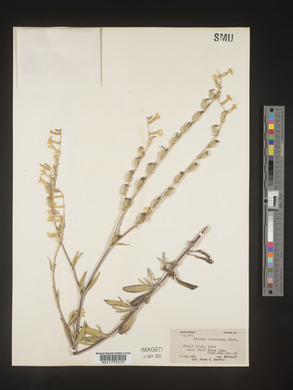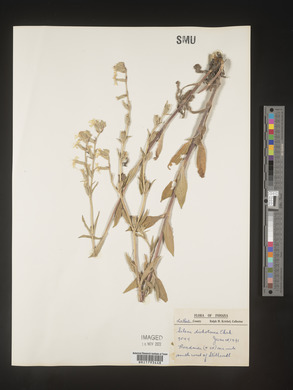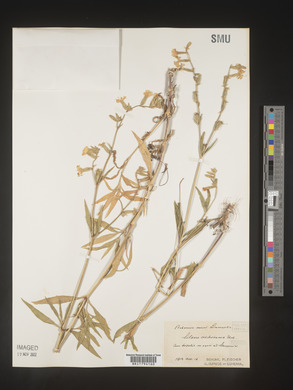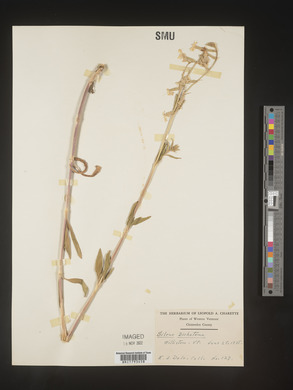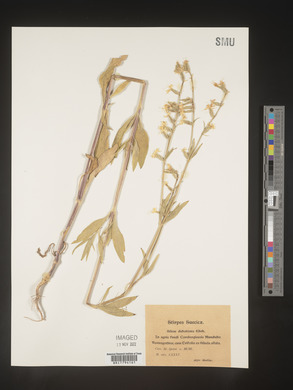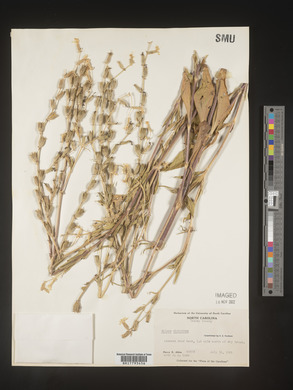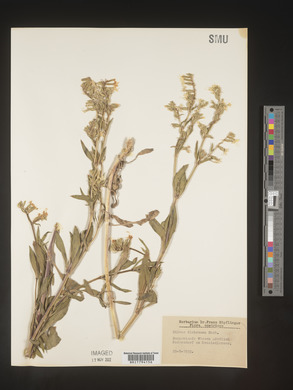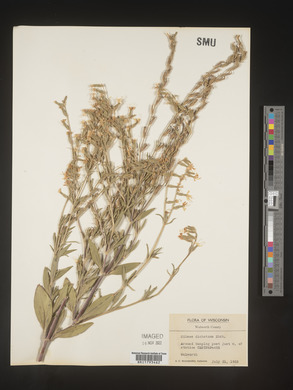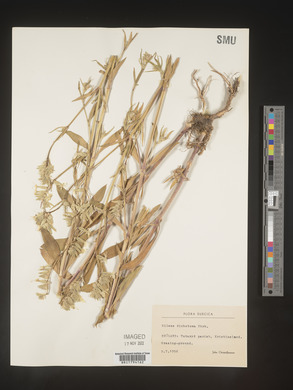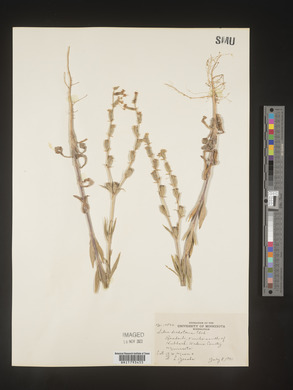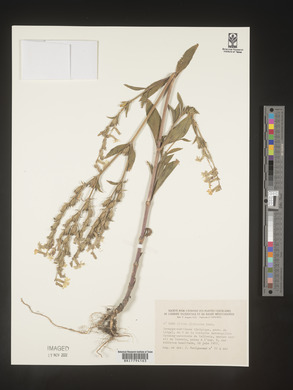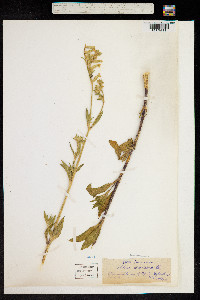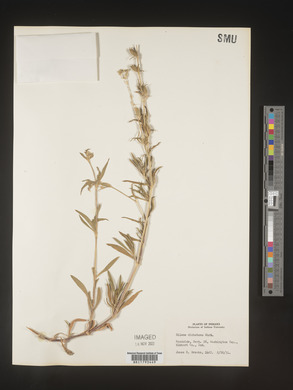Silene dichotoma
|
|
|
|
Family: Caryophyllaceae
Forked Catchfly, more...Forked Catchfly
[Silene dichotoma subsp. dichotoma] |
Plants annual, robust; taproot slender. Stems erect, branched distally, usually reddish, (20-)50-100 cm, coarsely hispid. Leaves 2 per node; proximal petiolate, blade lanceolate-spatulate, 3-10 cm × 6-30 mm (including petiole), base tapering into petiole as long as lamina; cauline sessile or nearly so, smaller distally, blade lanceolate-cuneate, 1.5-5 cm × 3-15 mm, apex acute, hispid on both surfaces. Inflorescences with many ascending, elongate branches, many-flowered, open, setose, glandular or not but not viscid; flowers 1 per node; bracts ranging from resembling leaves to narrowly lanceolate, 5-10 mm, apex caudate-acuminate. Flowers subsessile; calyx prominently 10-veined, not inflated, setose, lobed, tubular in flower, ovoid and (7-)10-15 × 2.5-4 mm in fruit, veins parallel, with pale commissures; lobes 5, spreading to recurved, narrowly lanceolate, 2-3 mm, apex acuminate; petals white, rarely pink, clawed, claw equaling calyx, limb obovate but deeply 2-lobed, 5-9 mm, apex truncate, appendages 0.2 mm; stamens exceeding petals, reduced to staminodes in some flowers; filaments white; styles 3, white, ca. 2 times calyx. Capsules enclosed in calyx, ellipsoid, opening by 6 spreading, lanceolate teeth; carpophore stout, 1.5-4 mm, glabrous. Seeds grayish brown to black, broadly reniform with concave faces, ca. 1 mm diam., rugose. 2n = 24. Flowering summer. Cultivated land, roadsides, burnt clearings in forests, disturbed prairies; 0-2200 m; introduced; B.C., Nfld. and Labr. (Nfld.), Ont., Que., Sask.; Calif., Colo., Conn., Ga., Idaho, Ill., Ind., Iowa, Ky., Maine, Mass., Mich., Minn., Mo., Mont., Nebr., N.H., N.J., N.Y., N.C., Ohio, Oreg., Pa., Tenn., Tex., Vt., Va., Wash., W.Va., Wis., Wyo.; Europe. Subspecies dichotoma is an occasional adventive weed.
Annual herb with a taproot 30 cm - 0.8 m tall Stem: densely hairy. Leaves: opposite, stalkless above, hairy-stalked below, 3 - 8 cm long, 0.5 - 3.5 cm wide, lance-shaped to reverse lance-shaped, densely hairy. Inflorescence: a forking (dichotomous) cluster of several flowers (raceme), subtended by bracts. Flowers: white to reddish. Stalk upright. Stamens ten. Styles three. Sepals: fused at the base into a narrow tube (calyx). Calyx tube 1 - 1.5 cm long, ten-veined (veins hairy), with five short lobes. Petals: five, white to reddish, 5 - 9 mm long, diamond-shaped to triangular, narrowly clawed, deeply two-lobed. Fruit: a dehiscent capsule, three-chambered. Seeds about 1 mm wide, finely wrinkled. Similar species: No information at this time. Flowering: late June to early August Habitat and ecology: Introduced from Europe. Formerly cultivated as a garden flower. An occasional escape as a garden weed. Has also been found in a roadside ditch. Occurence in the Chicago region: non-native Etymology: Silene probably comes from the Greek word sialon, meaning saliva, referring to the sticky secretion on many of these plants. It may also have come from the word seilenos, referable to Silenus-a foam-covered, drunken character in Greek Mythology. Dichotoma means "forked or divided in pairs." Author: The Morton Arboretum Strongly hirsute annual 3-8 dm; lvs lanceolate to oblanceolate, 3-8 cm נ3-35 mm, the lower usually ciliate-petiolate, the upper sessile; infl usually one or more times dichotomous, with leafy-bracteate, monochasial, raceme-like branches; fls mostly perfect; cal narrowly tubular, 10-15 mm, the 10 green nerves hirsute; pet white to reddish, without auricles, the appendages truncate, 0.2 mm, the blade rhombic-cuneate, 5-9 mm, deeply 2-lobed; stamens exsert (or vestigial); carpophore 2-4 mm; fr 3-locular; seeds 1-1.3 mm wide, finely rugose; 2n=24. Native of Eurasia, widespread as a weed in the U.S. Summer. Gleason, Henry A. & Cronquist, Arthur J. 1991. Manual of vascular plants of northeastern United States and adjacent Canada. lxxv + 910 pp. ©The New York Botanical Garden. All rights reserved. Used by permission. From Flora of Indiana (1940) by Charles C. Deam I have found this species in two places, and in each it seems to be well established. In 1915, I found it to be common along the roadside 4 miles north of Vevay in Switzerland County. In 1931 I found it to be a common weed in a very sandy alfalfa field about 4 miles southeast of Mongo in Lagrange County. I revisited the place in 1932 and I found the field in corn but the plant was frequent along the sandy roadside which bordered the field; and I found it still persisting in 1937. I believe it is well established in both places and it is entitled to membership in our flora. It has also been collected in Fountain, Fulton, and Lawrence Counties. …… Indiana Coefficient of Conservatism: C = null, non-native Wetland Indicator Status: N/A |



